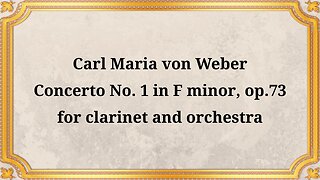Premium Only Content

Robert Schumann Sonata №2 In G Minor, Op 22
#ClassicalMusic #MusicalComposition #RobertSchumann #SonataNo2 #GMinor #Op22 #Piano #RomanticEra #Virtuoso #MusicalForm #EmotionalDepth #ExpressiveMelodies #HarmonicExploration #PianisticChallenges #GermanComposer #19thCentury
Joerg Demus piano
Robert Schumann, a renowned German composer of the 19th century, left an indelible mark on the world of classical music. Among his notable works is Sonata No. 2 in G Minor, Op. 22.
Schumann composed Sonata No. 2 in G Minor, Op. 22, during the Romantic era, a period characterized by heightened emotional expression and individualism in music. This composition, written for solo piano, showcases Schumann's mastery of the instrument and his unique musical voice.
The sonata follows a traditional three-movement structure: Allegro moderato, Scherzo: Allegro molto, and Presto. Each movement presents distinct musical ideas and themes, contributing to the overall narrative arc of the piece. Schumann's exploration of form within this sonata demonstrates his innovative approach to composition.
One of the defining characteristics of Schumann's Sonata No. 2 is its profound emotional depth. The composition is imbued with a range of moods, from introspective and melancholic to passionate and triumphant. Schumann's ability to convey a wide spectrum of emotions through expressive melodies and nuanced dynamics adds to the allure of this piece.
Schumann's Sonata No. 2 showcases his mastery of harmonic language. The composition features intricate harmonies and chromaticism, pushing the boundaries of traditional tonality. Additionally, the piece presents pianistic challenges, demanding technical virtuosity and dexterity from the performer.
Sonata No. 2 in G Minor, Op. 22, holds a significant place within Schumann's repertoire, representing his artistic growth and exploration during the Romantic era. It demonstrates his ability to infuse his compositions with profound emotional expression and innovative musical ideas. The sonata's enduring popularity has ensured its continued performance and appreciation by pianists and audiences worldwide.
Conclusion:
Robert Schumann's Sonata No. 2 in G Minor, Op. 22, stands as a testament to his musical genius and his ability to capture the essence of the Romantic era. Through its expressive melodies, harmonic exploration, and emotional depth, this sonata offers a transcendent experience for both performers and listeners alike. It is a testament to Schumann's ability to push the boundaries of musical expression and create a lasting legacy within the realm of classical music.
You have the opportunity to support the channel:
https://destream.net/live/RadSiarAl/donate
https://www.buymeacoffee.com/6355radsiaral
-
 20:31
20:31
Classical music_Music Inspiration
4 days agoCarl Maria von Weber Clarinet Concerto No. 1 in F minor, Op. 73
231 -
 1:23:26
1:23:26
RiftTV/Slightly Offensive
3 hours ago $3.62 earnedThe LUCRATIVE Side of Programming and the SECRETS of the "Tech Right" | Guest: Hunter Isaacson
13.8K6 -
 LIVE
LIVE
Phyxicx
4 hours agoLast minute practice before Sunday - 4/26/2025
279 watching -
 27:57
27:57
MYLUNCHBREAK CHANNEL PAGE
21 hours agoDams Destroyed India
22.8K12 -
 39:29
39:29
Stephen Gardner
3 hours ago🔥Pam Bondi drops NIGHTMARE NEWS on 3 top DEMOCRATS!
39K58 -
 31:26
31:26
The Brett Cooper Show
2 days ago $15.73 earnedI Spoke With People Close To Justin Bieber | Episode 25
35.4K75 -
 1:08:48
1:08:48
Winston Marshall
1 day agoThe Damaged Generation: How Lockdown Damaged 50 Million Children For Life with David Zweig
62.6K71 -
 LIVE
LIVE
Eternal_Spartan
7 hours agoLive at 11am Central!! | Clari Obscur Expedition 33 - Possibly the Best Game of My Life?!?
149 watching -
 13:05
13:05
Cowboy Kent Rollins
1 day ago $12.44 earnedHomemade Cowboy Corn Dogs | Easy Corndog Recipe
58.5K25 -
 DVR
DVR
GritsGG
6 hours ago#1 Warzone Win Grind! 🔥
28.5K6